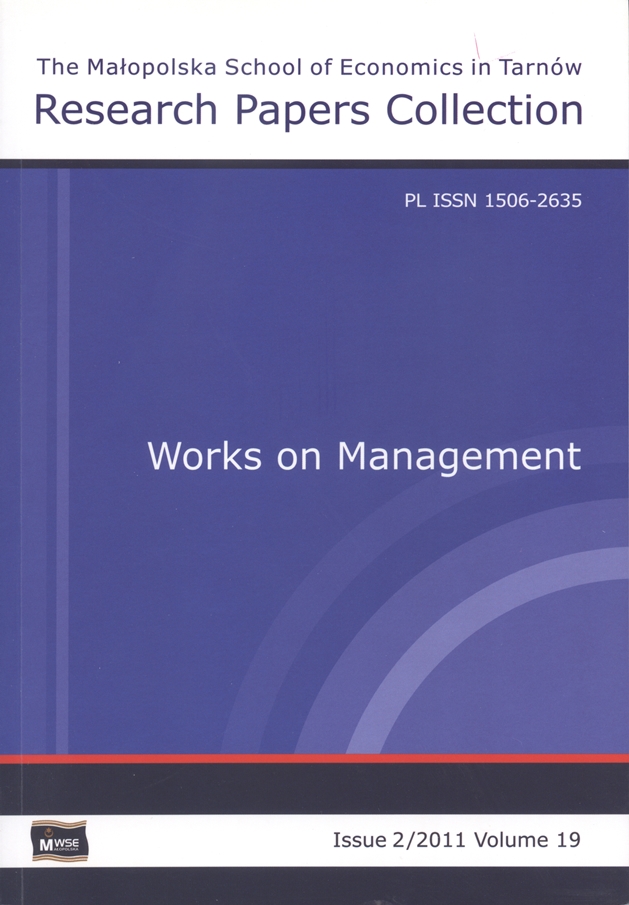Abstract
The paper presents the key substantial and methodological aspects of motivation for work, with special attention paid to the analysis of classification of motivating factors. The selected, more important of them, have been described. A new approach to them has been presented in the form of the concept of trychotomy of motivating factors at work (i.e. in the environment, in the situation of work), which constitutes the evolution of the two-factor theory by Frederick Herzberg. This concept lists three groups of factors: “motivators” give satisfaction when present, “factors of hygiene” cause dissatisfaction when not present, and “demotivators” cause dissatisfaction when present. Their vectors of effect on satisfaction with work differ radically, although they are present at the same time in the work environment. That is why this concept constitutes the methodological directive which suggests expansion of the field of analysis of the conducted research by the factors which reduce motivation in the workplace.
References
Adair J. 2000. Motywacja. Transl. by D. Bakalarz. Warszawa: Wydawnictwo Studio Emka. ISBN 83-88607-00-6.
View in Google Scholar
Adamus W., Szara K. 2000. “Zastosowanie Analitycznego Procesu Hierarchicznego AHP do racjonalizacji zarządzania i organizacji gospodarstw (przedsiębiorstw)”. Zagadnienia Ekonomiki Rolnej, no. 4-5.
View in Google Scholar
Armstrong M. 2005. Zarządzanie zasobami ludzkimi. Transl. by A. Hędrzak et al. Kraków: Oficyna Ekonomiczna. Oddział Polskich Wydawnictw Profesjonalnych. ISBN 83-89-355884.
View in Google Scholar
Gagne M., Deci E. L. 2005. “Self-determination theory and work motivation”. Journal of Organizational Behavior, no. 26.
View in Google Scholar
Hackman J. R., Oldham G. R. 1975. “Development of the job diagnostic survey”. Journal of Applied Psychology, no. 60.
View in Google Scholar
Hellwig Z. 1968. “Zastosowanie metody taksonomicznej do typologicznego podziału krajów ze względu na poziom ich rozwoju oraz zasoby i strukturę wykwalifikowanych kadr”. Przegląd Statystyczny, no. 4.
View in Google Scholar
Iwasiewicz A. 2000. Metody statystyczne w zarządzaniu jakością, [online, accessed: 2011-10-31]. Available online: http://www.statsoft.pl/czytelnia/jakosc/jametstatystyczne2.pdf.
View in Google Scholar
Kozińska A., Szybisz J. 2005. “Jak nie demotywować pracowników”. In: Motywować sku¬tecznie. Ed. S. Borkowska. Warszawa: Instytut Pracy i Spraw Socjalnych. ISBN 83-87890-56-1.
View in Google Scholar
Kozioł L. 2002. Motywacja w pracy: Determinanty ekonomiczno-organizacyjne. Warszawa and
View in Google Scholar
Kraków: Wydawnictwo Naukowe PWN. ISBN 83-01-13786-X.
View in Google Scholar
Lozano Platanoff A. 2009. Zarządzanie dynamiczne: Nowe podejście do zarządzania przedsiębiorstwem. Warszawa: Difin. ISBN 978-83-7641-079-1.
View in Google Scholar
Michoń F. 1981. Organizacja i kierowanie w przedsiębiorstwie w świetle socjologii i psychologii pracy. Warszawa: Książka i Wiedza.
View in Google Scholar
Nadler D. A., Lawler E. E. 1977. “Motivation: A Diagnostic Approach”. In: Perspective on behavior in organizations. Ed. J. R. Hackman, E. E. Lawler. New York: McGraw-Hill. ISBN 9780070254138.
View in Google Scholar
Pietrasiński Z. 1965. Praktyczna psychologia pracy: Zagadnienia wybrane. Warszawa: Wiedza Powszechna.
View in Google Scholar
Rheinberg F. 2006. Psychologia motywacji. Transl. by J. Zychowicz. Kraków: Wydawnictwo WAM. ISBN 83-7318-640-9
View in Google Scholar
Smoleński S. 1999. Menedżer przełomu wieków. Bydgoszcz: TNOiK [Towarzystwo Naukowe Organizacji i Kierownictwa] and Oficyna Wydawnicza Ośrodka Postępu Organizacyjnego. ISBN 83-87636-63-0.
View in Google Scholar
Stelmach W. 2005. Ciemne strony kierowania. Warszawa: Placet. ISBN 83-85428-99-2.
View in Google Scholar
Steward D. M. (ed.). 2002. Praktyka kierowania. Transl. by A. Ehrlich. Warszawa: Polskie Wydawnictwo Ekonomiczne. ISBN 83-208-1404-9.
View in Google Scholar
Warszewska-Makuch M. 2007. “Polska adaptacja kwestionariusza NAQ do pomiaru lobbingu”. Bezpieczeństwo Pracy, no. 12.
View in Google Scholar
© Copyright by Małopolska School of Economics in Tarnów. The articles are available under the Creative Commons Attribution NonCommercial-NoDerivatives 4.0 International License


